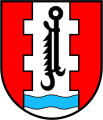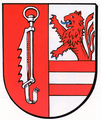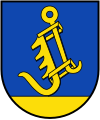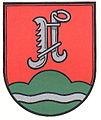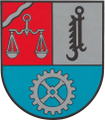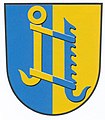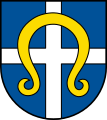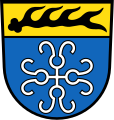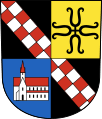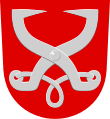Boiler hook
The Trammel and Kesselring found in the heraldry as common figures in blazon their place as arms or or field Herold image . The boiler tongs are also common in heraldic art. They were much-used utensils for handling the hot kettle. Numerous other names are common for these three devices depending on the region. The kettle hook is also called Kesseleisen , Ketelhaken , Hal or Hahl (ndl. Haal ). It was a device for hanging the kettle in an open furnace, especially in large chimneys or over an open fire. Other terms for the same issue: Hähl, Haul, Potthohl.
As always shown in the coat of arms, it has teeth . These are used for adjustability: the kettle hook usually consists of a flat iron with teeth, which is bent up at the lower end so that the kettle can be hung. A rod that is used to hang over the fireplace usually runs parallel to the flat iron. Both parts are connected by guides, a movable hook can be hooked into each tooth and thus the length of the suspension device can be changed. Crank devices, similar to a rack and pinion winch, are less common . For wealthy owners, the individual parts were often engraved or artfully forged .
Rinken or Kesselrinken is the name of the kettle ring, which is a handle on the kettle. A set with boiler Rinken Cross is church clip called. The pliers were used to lift out the kettle. The term Hafte as a name for Kesselring could not be found in the literature, although it is used in descriptions of coats of arms ( blazon ). The three-legged saucepan is also called Grapen .
The boiler hook as a symbol
In a farmhouse, the hearth was the center of the building. Only from here did heat emanate. Here was cooked and fried.
The kettle hook was important for cooking. In earlier centuries it was part of the furnishing of the hearth fire. With its help, the pot or kettle could be brought closer to the fire or removed from it. This is used to explain the saying “step up a gear” over and over again. This is wrong. One tooth less on the kettle hook made the food in the lower pot cook faster. "Down" does not mean "more" in any culture, as the word "increase" clearly indicates. In addition, the phrase only emerged in the 19th century, the age of mechanization and locomotives. At the time, people imagined that one more tooth on a gear wheel was driving faster. Locomotives also had steam pressure levers that were fixed in a half-toothed ring on the floor. If you stepped up a gear, the locomotive ran faster with more steam.
The kettle hook also had legal historical significance. When a house passed from one owner to another, the landlord removed the kettle hook and gave it to the buyer. Then he poured out the fire.
In some cases it was customary for the young farmer to give his bride a magnificently crafted halo, symbolically entrusting her with authority over the kitchen and stove.
Depiction - kettle hooks in the coat of arms of places and families
In heraldry, the kettle hook appears in different forms.
In the simplest variant, only one part of the entire kettle hook appears, namely a flat, toothed metal rod, the so-called " rack ", which usually ends in a rounded, ring or semicircular eye at the top and a curved hook or something at the bottom Comparable. It appears mainly in one or three numbers, possibly based on large castle chimneys, where sometimes three racks were hung next to each other on a frame.
Boiler hook in the old shape of a rack
Heinrich von der Betten 1585
In gold, three overturned black boiler hooks ("Kräuel" or "Craile") Crailsheim next to each other
Crossed kettle hooks (Kräuel) and raftsman hooks ( Schwäbisch Hall district )
Two turned away, fallen racks ( Bieselsberg )
Another form of the heraldic kettle hook shows, in addition to the rack, a flat iron that is connected to the rack via metal rails. The upper rail is usually used for guidance, the lower one for stopping by making a notch in the rack.
Boiler hook in the general form: places
Alvesse (Edemissen) , on the right a boiler hook
Borstel (district of Diepholz) , a boiler hook in the middle
Overturned boiler hooks ("Kräuel" or "Craile") in Crailsheim , talking
Leveste , on the left a boiler hook
Marxen , on the left a boiler hook
Hörden am Harz , a boiler hook
Rechtenfleth near Bremen
Schwalmtal (Hessen) , top left a boiler hook
Römstedt , at the bottom right a boiler hook
Left blue boiler hook Radenbeck (Wittingen)
Hemmoor , top right a boiler hook
Hohenbostel , top left a boiler hook
Hollnseth , the four kettle hooks stand for the first four yards
Sierße , municipality of Vechelde in the district of Peine
Boiler hook in the general form: families
Brandlecht , conspicuous, the lower hooks are curved in the same direction
Three (2: 1) black Deersheim boiler hooks
Coat of arms of the prince abbot of Fulda Adalbert von Schleifras
Complex shapes of the boiler hook in coats of arms
In addition to the above-mentioned forms of the kettle hook, heraldry knows other, sometimes more complex.
(Westphalian) kettle hook in the coat of arms of the von Ketteler family
(Westphalian) kettle hook in the coat of arms of the Counts of Heyden
Upright open boiler hook Barons von Twickel
Further coats of arms with boiler hooks not shown
In the arms of the families: von Duhn, barons von Hadeln and Waldvogel.
Representation - Similar symbols in the coat of arms of places
- Kesselring (Rinke)
" Kesselring (panel XXVII. Figure 83.) is the ring or handle of a kettle ...."
Grömbach in the Black Forest
Östringen between Karlsruhe and Heidelberg
Kesselring in the Polish family coat of arms Nowina
- Church clasp (Rinkenkreuz)
Kirchheim unter Teck southeast of Stuttgart

- Kesselzange (French: paire de tenailles de chaudron ; English: pair of tongs for the kettle ) is supposedly a mean figure in heraldry . (see right)
" Kettle tongs (Plate XXVII. Figure 82.) is an instrument that is used to lift the glowing kettle out of the fire."
To what extent there is possibly a misinterpretation regarding the motive, more in-depth research must show. In fact, the term “Kesselzange” is rarely used in German. It is not listed in the Grimm dictionary or in any other leading encyclopedia or dictionaries. Coats of arms, which according to the relevant literature allegedly show boiler tongs, sometimes represent a completely different form of tongs (see section below).
- Demarcation
The boiler tongs are confused in some sources with "tree tongs" as they are used in forestry. The latter appears, for example, in some Northern European coats of arms or in coats of arms from regions that practice intensive forestry.
- Tree tongs
Web links
- Boiler hook . In: Heinrich August Pierer , Julius Löbe (Hrsg.): Universal Lexicon of the Present and the Past . 4th edition. tape 09 . Altenburg 1860, p. 445 ( zeno.org ).
- Leveste a place southeast of Hanover with a kettle hook in the coat of arms: The kettle hook - what is it?
- Kettle hook museum in Freiensteinau near Fulda
- The boiler hook (Hahl) as a symbol
- Boiler hook in the Heraldry Wiki
Individual evidence
- ↑ Adelung, Grammatical-Critical Dictionary of High German Dialect, Volume 2. Leipzig 1796, p. 1559
- ↑ http://hgv45549.wordpress.com/2012/08/10/der-kesselhaken Heimat- und Geschichtsverein Sprockhövel eV Der Kesselhaken (Hahl) - 2012
- ↑ Description of the coat of arms: “In silver, diagonally crossed from a shield base quartered with silver and black growing, a black kettle hook (Kräuel) and a black raftsman's hook; in between there is a red disc with a silver cross inside. "
- ↑ Description of the coat of arms: "In red two turned away, overturned golden kettle hooks."
- ↑ arms of Rechtfleth online
- ↑ Description of the coat of arms: "In a field split in silver and blue over a cross river in confusing colors, a blue kettle hook on the left, a gold-armored silver crane on the right, holding a golden ball with its raised foot."
- ↑ The coat of arms of the community of Hollnseth was borrowed from the coat of arms of the communities of Abbenseth and Hollen, from which the unified community of Hollnseth was formed. The mill wheel and the wave strips are reminiscent of the old Hollener watermill. The kettle hooks are reminiscent of the first four farms in Abbenseth.
- ↑ a b Hermann Grote , Wappenbuch des Kingdom of Hanover, 1852, p. 5 to 7 Description of the coats of arms from the ceiling and from pits, panel C31, two coats of arms with boiler hooks: from pits and from the ceiling
- ↑ Coat of arms of the von Gustedt family online
- ↑ Coat of arms of the von Knuth family (Mecklenburg and Denmark) online
- ↑ Coat of arms of the von Knuth II family
- ↑ Description of the coat of arms: "In gold three (2: 1) black kettle hooks."
- ↑ Coat of arms of Adalbert von Schleifras in the Heraldik-Wiki
- ^ Coat of arms of the von Zerssen family (Zersen, Cersne, Tcersne, Zertschen) online
- ↑ Belmer Kesselhaken - On the history of the coat of arms!
- ↑ Description of the coat of arms: “ Diagonally divided by black and silver; in the silver half a black boiler hook. "
- ↑ Description of the coat of arms: “In silver an upright, open, black kettle hook. Three overturned, silver-tipped red pointed hats on the helmet with black and silver covers. "
- ↑ Coat of arms of the von Duhn family online
- ↑ Coat of arms of the von Hadeln family online
- ↑ Coat of arms of the Waldvogel family online
- ↑ a b J. Siebmacher's large and general book of arms, introductory volume, section B: Principles of the art of arms combined with a manual of heraldic terminology ( Maximilian Gritzner ). Nuremberg: Bauer & Raspe, 1889. Text: p. 129 = image 143 and coat of arms on plate 27 = image 447










